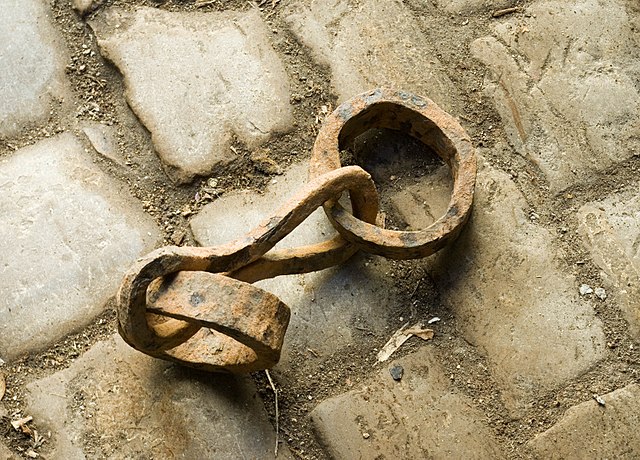
By JAMES BARON, The Free Lance-Star
STAFFORD, Va. (AP) – Historians say a recently restored log cabin that once
housed enslaved African Americans in southern Stafford County is a rare find in
Virginia, or anywhere else in the country.
“They were never built to last hundreds of years,” said Doug Sanford, a retired
professor from the University of Mary Washington’s department of historic
preservation. “This is truly a rare survivor.”
Sanford, who retired from the university in 2017, said hundreds of small slave
dwellings – such as the log cabin that’s situated on a hill near the southernmost tip of Lake Mooney – were a common sight throughout most of the
South during the 18th and 19th centuries.
In late 2014, Sanford, whose ancestors once owned the land the cabin stands on,
joined University of Maryland associate research professor Dennis Pogue and a
handful of University of Mary Washington students as part of a countywide study
conducted by Dovetail Cultural Resource Group of Fredericksburg. That study ran
until spring 2015, and its purpose was to locate any remaining slave quarters in
the county, along with long-forgotten cemeteries and other sites or structures
associated with slavery in Stafford.
“We realized just in that one year, there were so many of these, it was such a
common form of vernacular architecture,” Sanford said. “Today, what’s left is
just a low, low percentage of what was there.”
Sanford said out of the possible hundreds of slave quarters, only seven are
still standing.
“The modern decline of Stafford County’s agricultural economy and the rapid pace
and extent of residential and commercial development took its toll,” Sanford
said.
The research team also discovered a surprisingly high level of slave ownership
among white households in Stafford by combing through U.S. census reports.
Sanford said in 1860, Stafford County had a 60% slave ownership rate in that
demographic. Sanford’s fourth great-grandfather, Lawrence Sanford, whose 976-
acre farm included the recently restored cabin, owned 20 slaves, according to
Stafford’s 1820 census.
Lawrence Sanford, who was also a captain in Col. Gregory Smith’s company with
the 2nd Virginia Cavalry during the War of 1812, died in 1858 and is buried just
north of the cabin in the family cemetery. He left the farm to his wife Apphia,
who told census takers in 1860 she owned nine slaves who lived in three separate
structures on the property, which was sold four years later after Apphia’s death.
Over the years, the property changed hands until eventually ending up under
county control as part of the Lake Mooney reservoir that opened in 2016.
Pogue said the Lake Mooney cabin probably survived demolition over the years due
to its placement close to the property owner’s own home on the farm. He said in
the 19th century, it was common to erect quarters for enslaved workers away from
the primary residence of the farm.
The Burgess family took ownership of the land in 1860 and later converted the
cabin into a work shed, adding more years to its lifespan. Pogue said several
work tables were found in the structure, and a doorway that was added to the
cabin at some point had weakened the structural integrity of the building.
“It was pitched forward by 12 inches,” Pogue said. “That was a problem.”
Sanford puts the cabin at just over 170 years old, based on the types of nails
used, as well as identifying saw marks and architectural methods commonly used
during that period.
“It’s the late Antebellum era,” Sanford said. “It’s about 1850.”
Brion Southall, the county’s Parks and Recreation director, said when he first
took a look inside the cabin, he knew restoration workers had a difficult task
ahead.
“There was dirt piled up on one edge and the logs underneath that dirt had
gotten insects in them that had rotted.” Southall said. “The whole building was
falling over. Something needed to be done or we were going to lose it.”
Vintage Renovation and Construction of Winchester was hired to work on the 15-by-
12-foot cabin and started the six-month job in July 2021. Workers disassembled
much of the cabin and took the materials off-site for restoration or replacement
after giving the building an inspection from the floorboards to the rooftop.
“The flooring upstairs is quite nice and appears original based on its nails,”
wrote David Logan of Vintage Renovation. “It does appear the upper portion of
the cabin is in good condition.”
Wooden logs of the cabin were professionally treated to weather the elements.
Those that were rotted or damaged were either replaced with similar wood or
pieces were fabricated in a workshop. A new foundation was built at the original
corners of the building before workers returned the cabin and reassembled it at
its original site. Additional work included a new metal roof, lime daubing,
siding, doors and window frames.
Although the exterior of the cabin looks impressive and inviting, the cabin and
the crumbling structures that surround it are not open to the public. Southard
said hikers approaching the area should be cautious due to “several hazards”
that the county will eventually mitigate, including piles of debris, old
building materials and the presence of an old well.
James Tully, chairman of the county’s Historical Commission, said he hopes the
cabin and other historic sites like it across the county will soon be managed by
a county official.
“We’re hoping the cultural resource specialist will assist in not only the
enslaved persons cottage down at Lake Mooney, but all of the cultural resources
across Stafford County,” Tully said.
_____
For copyright information, check with the distributor of this item, The Free Lance-Star.


